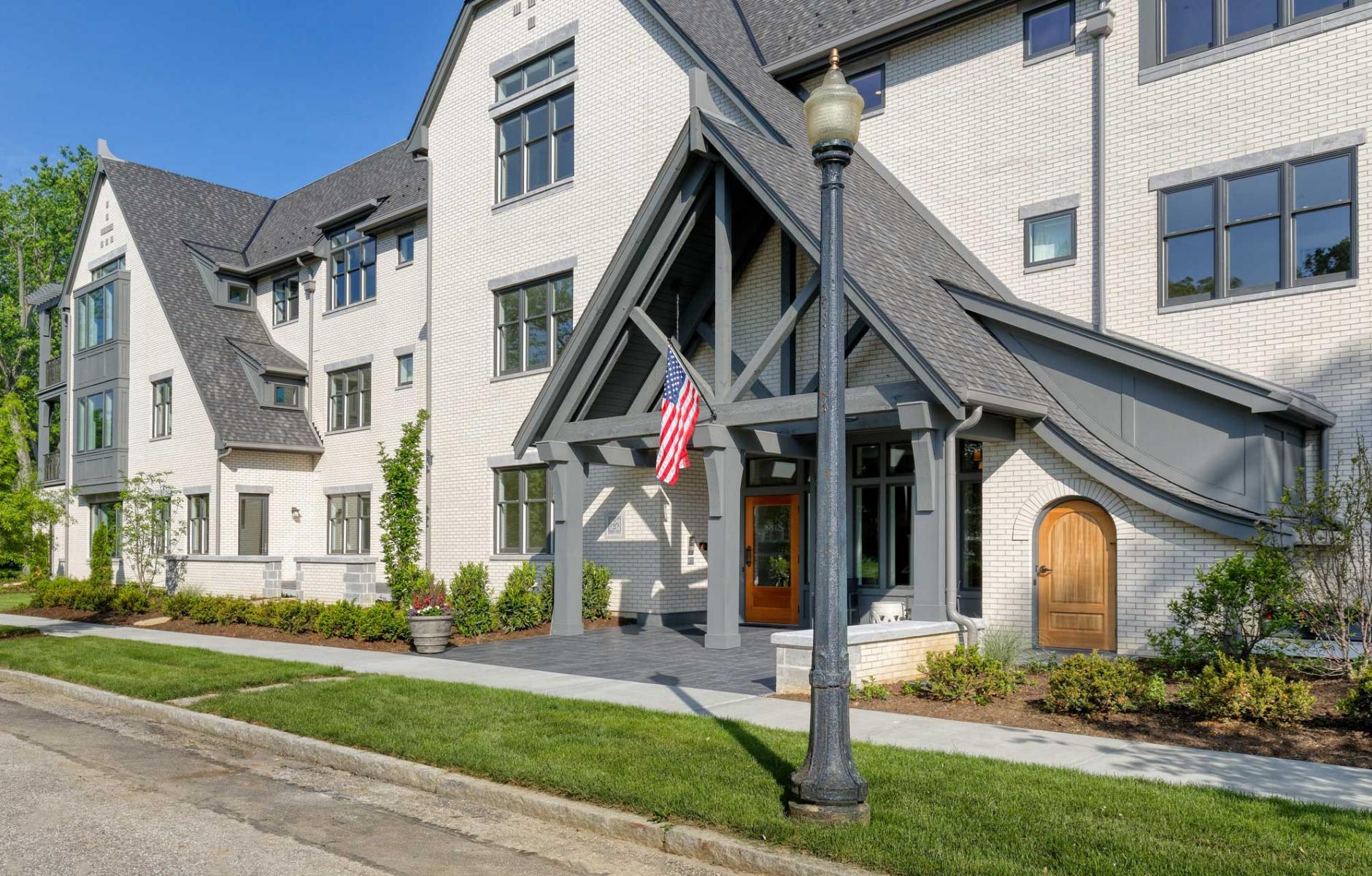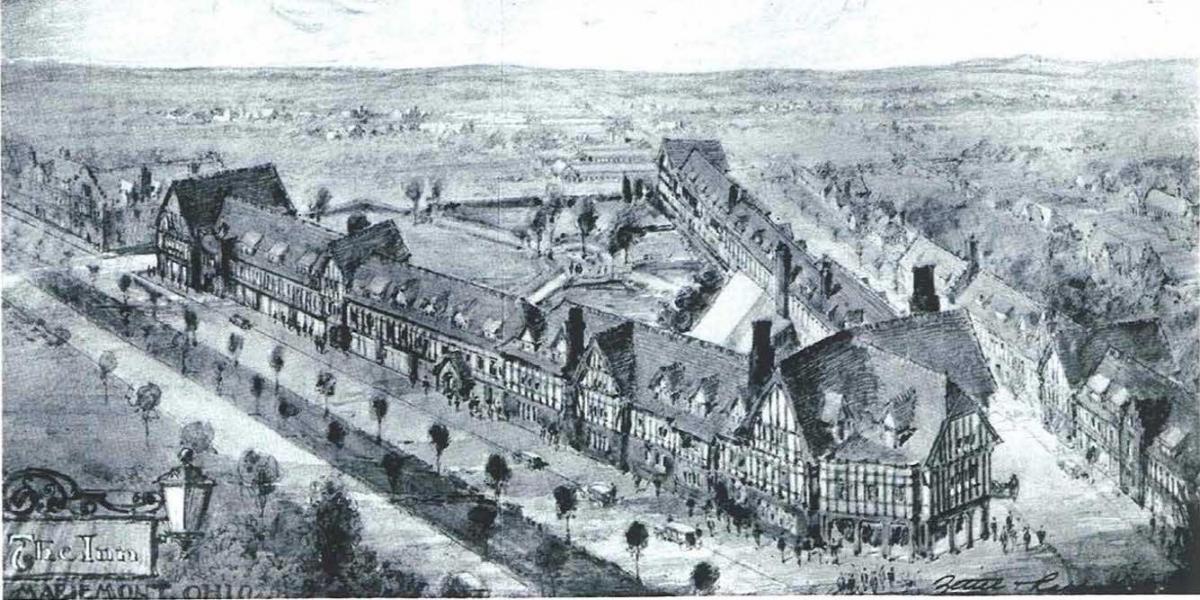
Mariemont: A timeless exemplar of town planning
Note: When CNU 32 convenes in Cincinnati May 15-18, attendees will learn from Mariemont, the town designed by John Nolen, among other notable places in the region.
On 23 April 1923, Mary Emery, known as “Lady Bountiful” for her support of the arts and social philanthropy, broke ground for Mariemont, Ohio, a 420-acre new town designed by John Nolen. The reform-minded Nolen and the conservative Emery (her attorney was Republican stalwart, senator Robert A. Taft) agreed that capital, if properly invested and cultivated, could produce a more humane and civic-centered life across the economic spectrum. Before drawing the plan, Nolen convinced Emery’s real estate advisor, Charles Livingood, to visit Letchworth and Hampstead, the iconic English garden suburbs designed by Nolen’s close friend Raymond Unwin. Upon Livingood’s return, it was decided that Mariemont would be their equivalent, a “National Exemplar” for the nascent American city planning profession. Set on a streetcar line ten miles east of downtown Cincinnati, the new town was designed to procure “modern happiness,” Nolen wrote, the “community well-being” to counter the “Jeffersonian superstition” that happiness was derived from absolute property rights.1
Nolen’s re-interpretation of Jefferson’s ideal was not an “experiment in social organization,” but as Emery directed, an effort to create “the best housing and community conditions possible . . . for the benefit of wage earners of different economic grades.”2 Nolen was well prepared for the challenge. During World War I, he designed six communities for workers in the munitions and shipbuilding industries under the auspices of the Department of Labor. The government required building market-based communities modeled on the English garden suburb that were “not an artistic or sociological experiment.”3 Skilled design and quality construction secured the first objective, but the federal initiative remained experimental, testing the proposition that the government could partner with planners and architects to provide worker housing. Union Park Gardens, today a cherished neighborhood in Wilmington, Delaware, illustrates the program’s success, which Nolen documented in a text written for the federal government, New Ideals in the Planning of Villages, Towns, and Cities. After the war, he was flummoxed when the expected “peace dividend” in federal housing was scuttled. “I am quite at sea myself as to what to do, or even what to recommend about housing here,” he confided to Unwin. “The way out appears increasingly difficult.”4

The Mariemont commission revived his hopes that “constructive imagination in business” could procure “widespread public welfare” by building new towns.5 A Harvard-trained landscape architect, Nolen was mentored by Frederick Law Olmsted, Jr. who oversaw his 1905 honors thesis, the first biography of Frederick Law Olmsted Sr. Following Olmsted protocol, Nolen drew the plan for Mariemont with “a reverence for site,” using topography and existing natural conditions to determine the community’s scale and form (see Figure 1). The lands least suited for development—floodplains, ravines, and steep slopes—were preserved in a broad swath of green that ran in serpentine fashion across the site. Trails led down to a wild setting, a half-mile stretch of creek at the bottom of a steeply sloped and forested ravine. On higher ground, athletic fields and playgrounds were linked into a network of parks located near schools and within an easy walk of residences. The town center, located at the property’s highest point, was set on an urban square marked the confluence of four radial avenues. The town hall sat on axis with the town square and a sublime natural feature, the Concourse, a scenic overlook of the Little Miami River.
One of the most pleasant walks in an American community is along the parkway connecting Mariemont’s town center to the Concourse. The shaded green corridor provides a gentle transition from civic buildings to Tudor revival apartments, to duplexes and single-family homes incorporating various interpretations of English architecture. At the end of the 15-minute walk, one encounters the Concourse, a half-moon, green jewel. A stone pergola with a timber trellis marks the park edge, providing framed overviews of a river valley resembling an early Thomas Cole painting (see Figure 2). Of course, this panoramic scene should come as no surprise. Designing parks to encapsulate picturesque vistas tied Nolen to the genius of Frederick Law Olmsted.

A team of architects reported to Charles Livingood. Nolen consulted the group, but Livingood had the final say. Friction arose, but the two men agreed to prioritize building worker housing in the Dale Park neighborhood. Designed in the manner of a traditional English village setting, it was located close to streetcar and bus lines with a bevy of rental properties: apartments, group homes, and townhomes. The lots for group homes (20 feet by 100 feet) and townhomes (30 feet by 100 feet) were Mariemont’s smallest, and with 325 units built at eleven units per acre, it was the town’s most densely developed area. The neighborhood center, a pair of three-story mixed-use buildings fronted a small green. The structure’s ground floors were dedicated to businesses, with standards for lighting and signage. Stone trim, proportioned gables, and window fenestration were the only decoration on the second- and third-story apartments. These simple adornments ensured that the building did not distract attention from the nondenominational Mariemont Memorial Church, an elegant gray stone structure sited across the green, inspired by the Anglo-Norman parish churches of the 12th and 13th centuries.6 Today, the sight lines between the church and neighborhood center synergizes a timeless civic art (see Figure 3).

The two-story group homes adjoining the Dale Park Neighborhood Center were built six to a section, with detailed stonework and half-timber-faced exteriors adorning the brickwork pattern used in the neighborhood center (see Figure 4). The attached units shared walls with allotment gardens located on the block's interior. Designed as the counterweight to the neighborhood center, a three-story Tudor-style apartment building was located on the opposite end of the block. Its stucco-facing and exposed timbers set the standard for the adjacent two-story group homes that filled out the block. Steep roofs and rounded door arches gave the units character, but they lacked the creative mix of stone and brick employed in the neighborhood center.

One block away, Maple Street’s Georgian Revival architecture added further interest and variety to the neighborhood. The “Honeymoon Cottage” over the entrance of Maple Street framed a charming terminating vista. To accentuate the view, front-yard setbacks were gradually reduced until they lost six feet in depth by the street’s end. The growth of the deciduous street trees enhanced the picturesque setting, and today Maple Street resembles the neighborhoods of Letchworth and Hampstead for its clarity and simple elegance (see Figure 5).

The Dale Park neighborhood was set on an east-west axis with two schools and the town center, a 10-square-block area. Mariemont’s intricate network of public spaces marked the transition with an intimacy and intent that surpassed Nolen’s previous commissions. Points of repose offered views of crafted greens, picturesque groupings of buildings, and expanses of nature. The village green was left in its forested state so that its deciduous trees matched the height of the surrounding two-story buildings. But it was a park on the edge of the Dale Park neighborhood that best illustrated Mary Emery's aspirations. There, three statues designed by the French sculptor Lucien Charles Alliot depicted the role that children play in communal life (see Figure 6). Ultimately, Mariemont’s claim to be a “National Exemplar” rested on Nolen’s ability to create an environment where children could comfortably find their way to parks, playgrounds, and schools.

By late 1925, Mariemont was prospering. Its population had reached five hundred, businesses were taking hold, lot sales were brisk, and residents were turning an experiment into a community. Using Nolen’s plan to market Mariemont, Livingood gained an audience well beyond Ohio. At the same time, Nolen presented the new town as a planning model to professional organizations in Europe and the United States. With construction in full swing, Nolen’s contract was terminated in late 1926. It was a mostly amicable parting. Nolen had opened a branch office in Jacksonville, Florida, and struggled to keep up with Livingood’s demands. The two had been challenged, but upon reflection, they realized the accomplishment of something special. Livingood appreciated Nolen’s dedication and the talent he had assembled. “At evening one feels as if . . . [the residents] were in an English village already,” he wrote the consultant. “We oriented [it] just right. Frankly I am wondering if there will be anything as beautiful as Dale Park where you took every advantage of nature.”7
By the Great Depression, Mariemont’s potential was fading. Rising inflation impeded construction of additional working-class housing, and the promise of providing homes for a range of incomes in a garden suburb was stymied. Despite the best intentions, Mariemont exposed the limitations of large-scale private planning. Yet there was a legacy. In 1936, a federal study assessing planned communities looked favorably on the Ohio new town, especially the Dale Park neighborhood, and its variety and quality of parks.
When automobile traffic increased exponentially after World War II, that town’s first significant problems arose. Nolen designed a community for the “motor age,” but he failed to fully gauge the automobile’s impact. Space allocated for allotment gardens was paved for parking, and commuter traffic overwhelmed the principal throughway.
Despite the automobile’s incursion, the town’s basic structure endured. Its walkable streets and the alignment of neighborhoods, parks, and schools made it easy for children to traverse their surroundings, and the town has drawn praise for the opportunities it affords children. Placed on the National Historic Register in 1979, Mariemont’s integration of apartments, townhouses, single-family homes, businesses, and civic buildings makes it a “model too important to ignore,” Andrés Duany contends.8 For a student of New Urbanism, the similarity between the plans for Mariemont and Seaside is not happenstance.
In 2008, the American Planning Association honored Marimont as “a prized artifact, and a vital, living embodiment of the value and benefits that sound planning principles return to multiple generations and lifetimes.”9 In 2011, Nolen’s skill in adapting the English garden suburb was recognized when Hampstead and Mariemont became sister cities. If the genius of Nolen’s plan is well documented, securing it remains a challenge.
In 2017, Rick Greiwe moved to redevelop two blocks of nondescript postwar Georgian apartments laid out in 4-unit cubes with a 30-foot setback in the town center. Offering a concept that better reflected the Nolen Plan, he proposed building 3-story condominiums in a Tudor revival style with a 10-foot setback. In meeting with public officials, Greiwe and designer Sari Lehtinen were shocked to learn that the town had an exemplar plan but no zoning regulations. In response, they made a deep study of Nolen’s work and its associated architecture.

Lehtinen recognized the need to mix art and rationality in this delicate urban environment. Inspired by the Mariemont Inn block (see Figure 7), and townhomes designed by Grovesnor Atterbury and Carl Ziegler, she labored to get the massing correct, and set the rhythm of roof shapes, gables, and entries. She also imagined the living experience, and how to employ terraces to unify the melding of nature and urbanism that Nolen celebrated. Height and density were also a concern, and the landmark Mariemont Inn offered a template. Tipping at three stories, the roofline of the 27-unit Nolen Park marks the apex of an inspired architecture that unifies brick, stone and modern materials that blend with its surroundings. In addition, landscape architect Martin Koekpe’s planting palette grounded the buildings in layers of shrubs, grasses, and trees that heightened the pedestrian experience (see Figure 8).

Nolen Park is one of four projects Griewe and Lehtinen completed in the town center. A fifth, Hampstead Park, lies immediately outside the area and responds to the duplexes and small lot homes in adjacent Albert Close. The white brick structure has a more romantic architectural style, but it follows the lines and massing of Lehtinen’s previous work. The pleasant aesthetic terminus to Albert Close shown in Figure 9 illustrates how building on the past can advance the “community well-being” that John Nolen foresaw. A century after its founding, Mariemont’s “anticipatory example” might yet yield the “smiling garden cities and towns” he envisioned.10 If it is to happen, New Urbanists must lead the way.
1 R. Bruce Stephenson, John Nolen: Landscape Architect and City Planner (Amherst: University of Massachusetts Press in association with Library of Landscape History, 2015), 119, 136.
2 Millard F. Rogers, John Nolen and Mariemont: Building a New Town in Ohio (Baltimore:Johns Hopkins University Press, 2001), 72.
3 Margaret Crawford, Building the Workingman’s Paradise: The Design of American Company Towns (New York: Verso, 1995), 168.
4 John Nolen to Raymond Unwin, December 28, 1920, box 8, John Nolen Papers (NP), Special Collections, Cornell University.
5 Rogers Jr., John Nolen and Mariemont, 50.
6 Rogers Jr., John Nolen and Mariemont, 119-121.
7 Ibid, 182.
8 Andrés Duany, Elizabeth Plater-Zyberk, and Jeff Speck, Suburban Nation: The Rise of Sprawl and the Decline of the American Dream (New York: North Point Press, 2000), 103.
9 Stephen Litt, “Great Neighborhoods,” Planning 74 (December 2008), 4.
10 John Nolen, New Towns for Old: Achievements in Civic Improvement in Some American Small Towns and Neighborhoods (1926; reprint, Amherst: University of Massachusetts Press in association with Library of Landscape History, 2005),120.




